A BRIEF HISTORY OF REDWATER CREEK STEAM & HERITAGE SOCIETY
By barbara wells
Our society came into being after the Second River Tramway at Karoola had to move from its position there. This railway was owned by the Martin, Allum, Proctor and Shennan families. Chris Martin by then was the Assistant Engineer with the Kentish Council and held talks with the General Manager and the then Warden, Grant Atkins and Laurie Connors. After several discussions, it was decided that a small group of enthusiasts would travel through the old formation to the Redwater Creek Falls. This they did on July 3rd. 1993 and again on July 11th. With another group, this time consisting of council staff, councilors and Kentish Service Clubs. It was around this time that it was mentioned that on this formation were waterfalls and caves. After much bush bashing the water falls and five caves were found.
The first media release was on August 24th. 1993.
Steering Committee.
At the end of August a public meeting was held in the Sheffield Town Hall where approximately 100 persons attended and was such a success that a steering committee was formed on the night.
The first members were Chris Martin, Coral and Eric Howe, Bruce and Marj Hutchinson, Wally Canniford, Mike Hancock, David Allenburg, Alistair Fraser, Dennis Rockcliff and Deborah Allum . Of that committee only Chris is still on the committee today. By October the inaugural meeting was held at Diversity, a business that was owned by a past member and Life Member, Koz and Beth Pagel.
The Kentish Council agreed to let the Society use their land to construct the planned track and heritage village. Also they agreed to purchase the block on the corner of main and Spring Street so the old railway station could be moved to this place.




The first sod was turned on October 30th. 1993. Many old house items were found during this time as the old house came straight up from the footpath and the back of it was where the station is now. The platform rock wall was constructed under the eye of Mike Hales with most of the work on the station foundations being done Chris & Peter Martin, Eric Howe, Gerry Weustenfeld and a group of Jobskills men.

Celebrations
At the third meeting it was suggested that we have an opening day. This was planned for November 12th. But because of the arrival of the new Spirit of Tasmania it was held a week later so all the invited dignitaries, who we had been invited, could attend. For the opening we had a golden spike (well one that was painted gold anyway). It was decided to ask a local by the name of Ian Jordan to do the honours. Ian had worked on the original line and at times had worked on every station along the route. Afterwards a luncheon was held in the Town Hall where invitees were treated to a Chicken and Champagne luncheon.
The Birth Of SteamFest
As a fund-raising event Eric Howe proposed that we hold a SteamFest to show off all the steam engines that we knew were in the district. It was thought if we got 500 people to the first one it would be a great achievement…well over double that turned up and that was the beginning of the very successful event we now hold on the March long week end. At the beginning we ran these events with around 20/30 people doing all the work, now we have over 200 workers and volunteers to run each day. There has only been one year SteamFest didn’t run and that was in 2001 because the National Rally was held in Tasmania and we supported the Historical Machinery Club of Tasmania with their rally. In 2015, when the next National Rally was held in Tasmania, our largest SteamFest ran the weekend after with many of the engines driving over a 3 day period between the events. Covid resulted in the 2022 SteamFest being cancelled due to a new strain of the pandemic arriving in Tasmania.
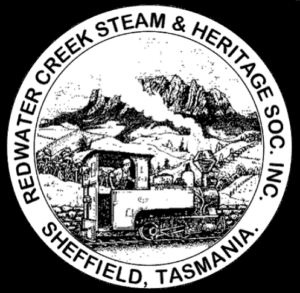
The Winning Logo
In the first year the society decided to hold a logo competition with the main prize being $100. There were 16 entries from locals and out of towners with the winner being Michael Wilkinson.
Track Laying.
The track laying began on Boxing Day 1993 with rail that had been pulled up from Karoola and from the Ulverstone rail yards. The track layers were Eric Howe, Wally Canniford, Laurie Connors, John Allum, Bruce Wing, John & David Barrass, Peter, Chris & Vivian Martin and Barb Wells. Well there’s always one that has no idea about anything and that one was me!! When it came to putting the bend in the rails Peter said “We’ll do the bend now!” well here’s me looking around for the bendy bits of rail and couldn’t find any so was silly enough to ask “Where are the bendy bits?’ Much laughter and then Peter said “we are going to bend them” again me thinking “Yeah right”. Oh! Boy! What a shock I got when I found out that was exactly what was going to happen. Out came this strange tool that I’d never seen the likes of before and this was followed by a crowbar (that I’d seen), still had no idea of what was coming next….I soon found out. Peter put the “crow” on the line and told Chris and I to swing on the bar and Oh! Magic, the straight rail starting to bend!!! After many moves around that rail we had a very nice (thank you) curved rail.
Rolling Stock
The rolling stock finally arrived on Feb. 26th. 1994 from Lilydale and the first run was on the night of the 27th. when the locomotive arrived in steam. The rolling stock consisted of:-
- PB1 otherwise known as the green carriage. It was a side loading carriage from Renison Bell (and possibly Queenstown prior to that) with a lower roof before the Second River Tramway chaps restored and modified it.
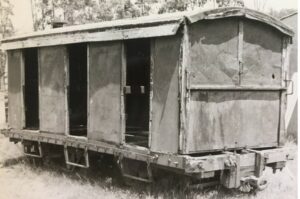
- DB1 -the red carriage, was constructed on part of a wooden framed flat wagon. Most of the body including the look-outs were from Tasmanian Government Railways Guards Van DB10. The building of the body was done by Ralph Proctor in Launceston in the seventies.
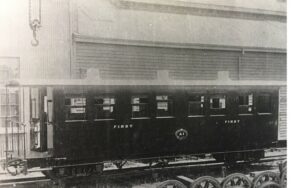
- A1 – the red carriage. This carriage was built about 1898 in the Tasmanian Government Railways in Launceston, and transported by sea to Strahan and then on the 3’6” gauge line to Zeehan where it was used on the North East Dundas Tramway. This carriage was in a derelict condition when it was bought at auction by Peter Martin in 1987. Over the next three years it was restored by Peter, Chris & Vivian Martin. Running gear and Air Brakes were installed by John Allum. The carriage was transported to Karoola by semi trailer in 1991.
- The Krauss is a composite locomotive built from the boiler and cab of 5682 a 2-4-0 with the underframe of 5800 in 1972 by the Second River Tramway. They began collecting parts in 1962. 5682 operated on the Sandfly Colliery line at Margate to 1921 then to the Ida Bay Railway to 1946. 5800 started out on the Zeehan Tramway running up and down the main street of Zeehan. Then to the Dunkley Brothers in Zeehan in 1935 and RJ Howard in 1952 when Renison Tin Mines purchased and used it to 1959.
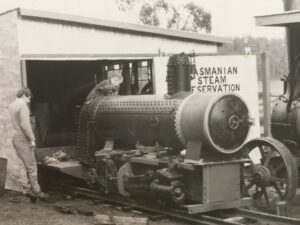
- Hunslet 1844 of 1936 was purchased from the Don Railway and has been an ongoing restoration project. It was initially purchased by the Australian Commonwealth Carbide Company and operated on the Ida Bay Railway to 1971. It was transported to David Von Stieglitz farm at Evandale and was used to train Don River Members from 1974 to 1977 in steam driving before the Don operations commenced. After restoration works it had a return to the Ida Bay Railway from 1992 to 2000. A new fire box was constructed soon after its return by Redwater Creek member Peter Martin and Don River Railway member Ray Howe.

First Train Since 1957.
What a sight it was to see the little Krauss chugging up the track and arriving at the Sheffield Station, the first train since 1957 was a sight to be seen. By the end of that weekend, we finally had the loco shed to lock up stage – anyone thinking that there was some pressure to perform miracles in those early days is probably right.
Old House from Nook.
The Society was given an old house from Nook for our use. There are two buildings from this property left today. The history of this house is it was built by William Morgan, who was a Canadian who came out to show our bushmen how to use tree climbing shoes to cut down trees. The house was 115 years old when we got it in 1994.
October Fest.
Over the next few years several of these functions were held at the Claude Road Hall. Otherwise known as a German night, these were attended by a large gathering of people with over 200 on the first one. We had German beer and food, along with some Aussie food. We even had a 5kg can of Sauerkraut, and a brass band that played German music.
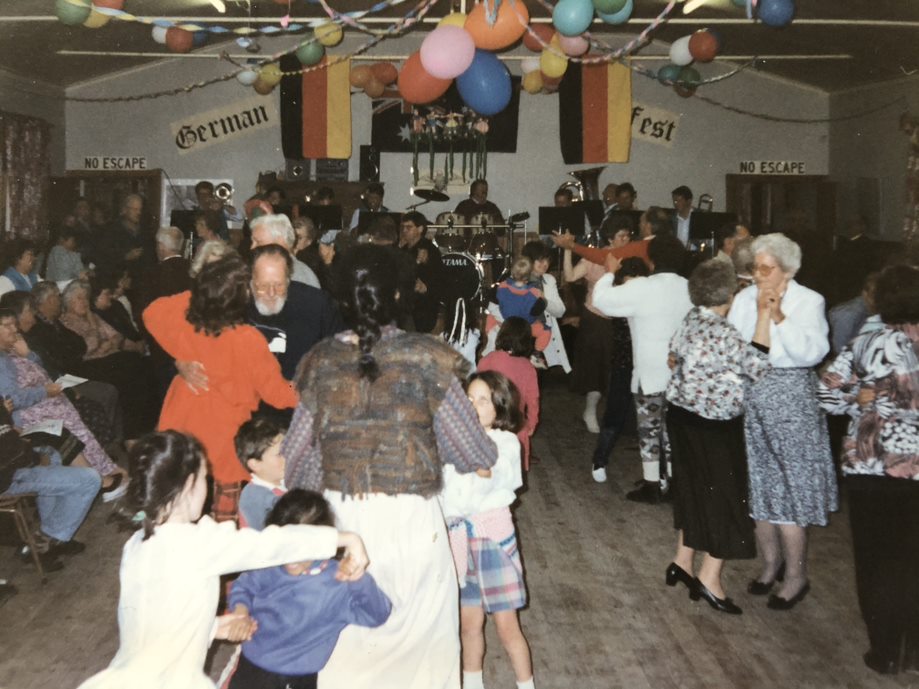
A Red Flag. The society was moving along quite well unto November 1994 when all capital construction on site had to cease. The planning approval that we were first given was now rebuked. Our property was now classed “Tourist” so therefore we did not have planning approval to continue on our way. The whole episode ended up before the Planning Tribunal and we were restricted to only a one kilometre track.
Shed Extension
After five years we were very short of storage so we extended the loco shed. Plans were drawn up and presented to council for approval. The extensions were an 8 x 15 mt extension on both sides of the original 9 x 15m shed. Approval was finally granted in April 2000 and it was finally under construction by September with the eastern side done first.
Photo of shed extension
Krauss Locomotive Birthday.
We planned to celebrate the centenary of the Krauss and most people were told that. Instead we were also planning to induct our first four Life Members. There were a lot of secret emails and low whispers when the four concerned were around. Finally the day arrived and we had managed to keep “Mum”. We held the dinner in the Sheffield Cricket Club rooms. Dinner consisted of Pumpkin or Veggie Soup, Chicken or lamb Roast with veggies and sweets were fruit salad, ice cream or meringue with strawberries and chocolate shavings. While I was again the chief cook I had good friends help out.
Later, when Chris got up to say a few words and made the announcement of the Life Members, his parents and the Allum family were totally speechless. Chris’s mother, Margaret said to me later that when on the way to the club rooms she had told Chris “that he had better say something nice about your father” little did she know that he had a whole speech ready.
Of the Krauss’s 100 years John Allum and Peter Martin had been the custodians of it for 44 years.
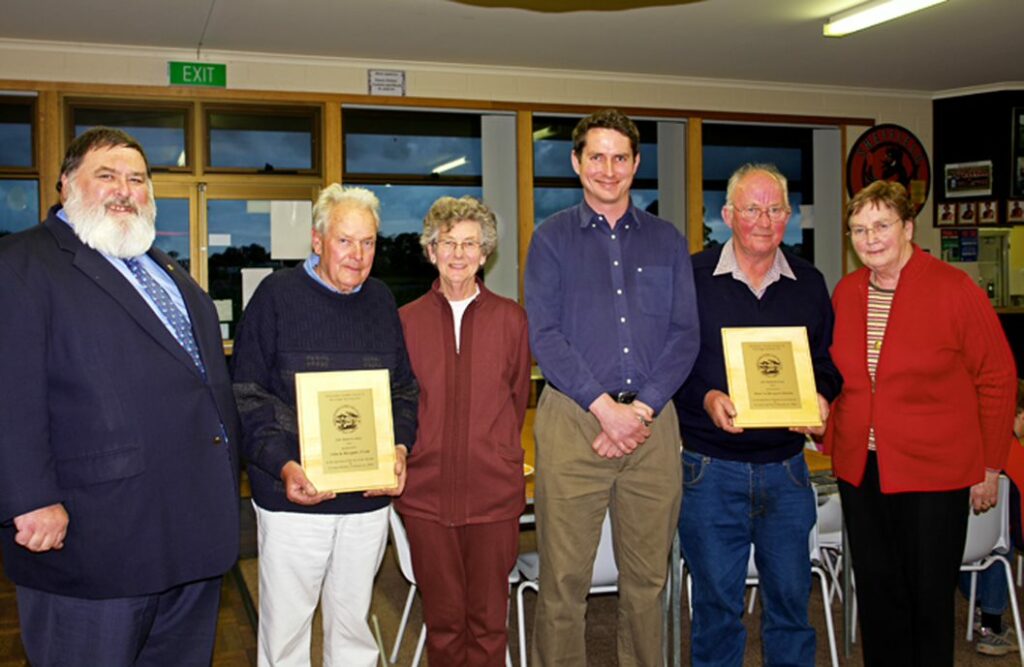
This is a very short history of the Redwater Creek Railway. Much more can be found in the book Railton – Roland Branch Line. Barb Wells.